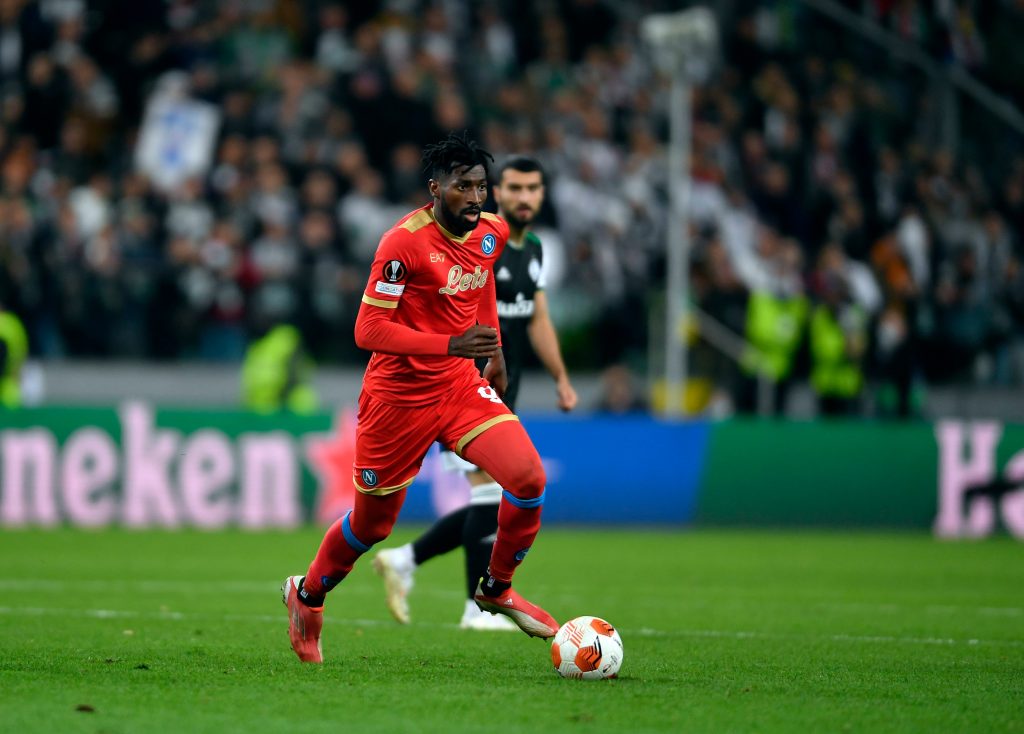Alex Stewart and Tom Underhill look at the Napoli midfielder, whose high transfer fee when joining Fulham was seen as emblematic of the failures in their scouting, but who has since gone on to excel in three Top Five leagues
“To this day Tony Khan thinks Fulham had a good transfer window in the summer of 2018. Which is sweet.” So wrote Jonathan Liew in a fairly recent piece on the spending habits of teams promoted to the Premier League. Fulham’s window in 2018/19 continues to be a cautionary tale, in large part because of outcome bias: spending around £100 million, only to be relegated with a meagre 26 points and a woeful 81 goals conceded, shows something must have gone wrong, right?
Indeed, Tony Khan’s data-heavy transfer approach was widely ridiculed at the time. One piece, which did correctly point to a number of other issues, stated:
“Fulham’s transfer policy last summer was pretty much a stereotype of everything wrong with modern Premier League spending – lots of money splashed on exotic names to excite supporters on social media, but lacking any coherent plan.”
Of course, Fulham didn’t get everything right that window, mostly in goal and defence, and almost certainly overplayed their financial hand on several players, more in wages than in fees in some instances. But their tactical approach, which had produced some beautiful football in the Championship under Slaviša Jokanovic, raised alarm in some quarters, with Statsbomb astutely noting in their 2018/19 Season Preview that “should the season not go strongly, this is not a squad built to eke out points and stay above water. In a relegation fight, a good defense [sic] is slightly more important than a good attack”.
As Jokanovic’s side struggled with injuries, chopped and changed tactics, and shipped goals at an alarming rate, it seemed like the promise of all that creativity had evaporated under the glare of the Premier League’s difficulty and intensity. In came Claudio Ranieri, who could not steady the ship, before Scott Parker took over to oversee the inevitable relegation and begin the rebuild (Parker essentially had zero chance of saving Fulham, so was astutely appointed with an eye to the future).
And this is why outcome bias plays a part in assessing all these transfers. Had Fulham stayed up, Khan could have been the poster-boy for data-driven recruitment. While Fulham brought in 15 players across the course of the season, they only paid over £20 million for three of them, Jean Michaël Seri, Aleksandar Mitrovic, and André-Frank Zambo Anguissa. Seri’s value had actually peaked before Fulham signed him, coming off the back of a very strong season with OGC Nice, and he was widely expected to be a big success. Mitrovic is still at Fulham and still scoring, currently sitting third among all Premier League players for xG per 90 after seven games played. And Anguissa is now a key figure for Napoli, having enjoyed superb seasons at Villareal and, albeit against the backdrop of yet another relegation, back at Fulham in 2020/21.
Anguissa before Napoli
Anguissa is a fascinating case in point for how a player can be flagged because of data, fail to bed in for reasons such as injury, tactical shifts, and overall team performance, and then show themselves to be just as good as the data suggested they would be. Recruited from Marseille after a barnstorming couple of seasons, Anguissa was exactly the kind of two-way midfielder, excellent at breaking up opposition attacks and adding drive and passing in possession, who should have excelled in the Premier League.
ZAMBO Anguissa 17-18 vs 18-19. Often we see excellent players from Ligue 1 come to the PL and maintain that level. That hasn't happened thus far for Fulham, who have been a mess all over. pic.twitter.com/Mjdmw65j6m
— StatsBomb (@StatsBomb) December 21, 2018
This excellent piece by Peter Rutzler in The Athletic makes clear how Anguissa had developed in France, even impressing Marcelo Bielsa during the Argentine manager’s short stint at Marseille. Franck Passi, assistant to Bielsa and then caretaker manager during that season, saw Anguissa improve technically and tactically from the raw talent who had joined aged 19.
“The first day I put him on the pitch, I remember it was Angers, and I put him as a No 6 in front of the centre-half…That day, Frank did a fantastic job. At that time, I thought it was his position and still think it’s a great position for him. Because he has a lot of ability to cover all of the pitch, to tackle, to recover the ball. He thought he was a No 10 at first, and at the end, he was playing No 6 and No 8 (defensive and central midfield). For me, the job of Frank is fantastic from our 18-yard line to the 18-yard line of the opponent.”
Indeed, Anguissa’s defensive actions and heat map show a very busy player across a number of roles.



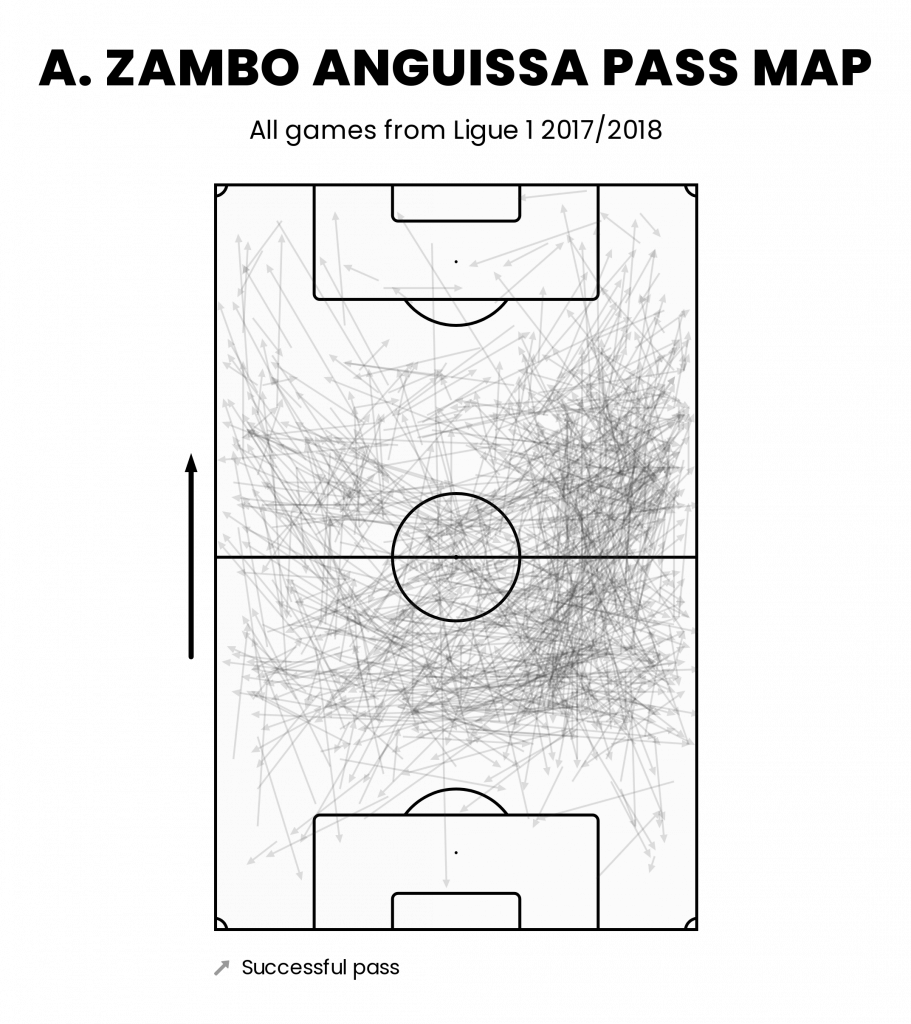
So when Fulham paid significant money for Anguissa on deadline line, the excitement was palpable: “If everything goes according to plan for Fulham, Anguissa will be the glue that knits together a better defense [sic] and a robust attack, turning the two halves into a cohesive whole.”
But he missed much of the relegation season, though, starting only 16 games and recording just over 1500 minutes, his lowest total in a full season since his breakthrough, aged 20, in 2016/17. And his stats reflected this poor and disjointed season. TransferLab’s time machine function allows us to look at how Anguissa was rated for the 2018/19 season against other midfielders in Europe’s Top Five leagues, and as a box-to-box midfielder, the results are not that pretty. Look, though, at how well he scores as a more defensive midfielder, which makes sense given how little Fulham were able to do with the ball. This set of metrics indicates someone desperately trying to stem the tide, while offering some high quality ball-progression through dribbling.

Once Fulham went down, Anguissa joined Villareal for the 2019/20 season on loan, and his rise since then has been marked. At Villareal, in a settled role that he was used to, unlike at Fulham, he could showcase his full-range of defensive and ball-carrying talents.
TransferLab rated him highly as a box-to-box profile midfielder, although his long passing and sharp-end, creative passing let him down. But again, this profile suggests a very tidy midfielder in possession, with a high output in defensive and ball-carrying terms, and he ably facilitated Villareal’s more creative passers.

The next season brought him back to Fulham, who had won promotion without him. And in a more settled team, albeit one again lacking the quality to stay up, Anguissa shone relative to midfielders in Top Five leagues. His ball-carrying was superb, while his all-round game improved markedly. The trajectory of a player who promised much and was clearly starting to deliver is very clear.
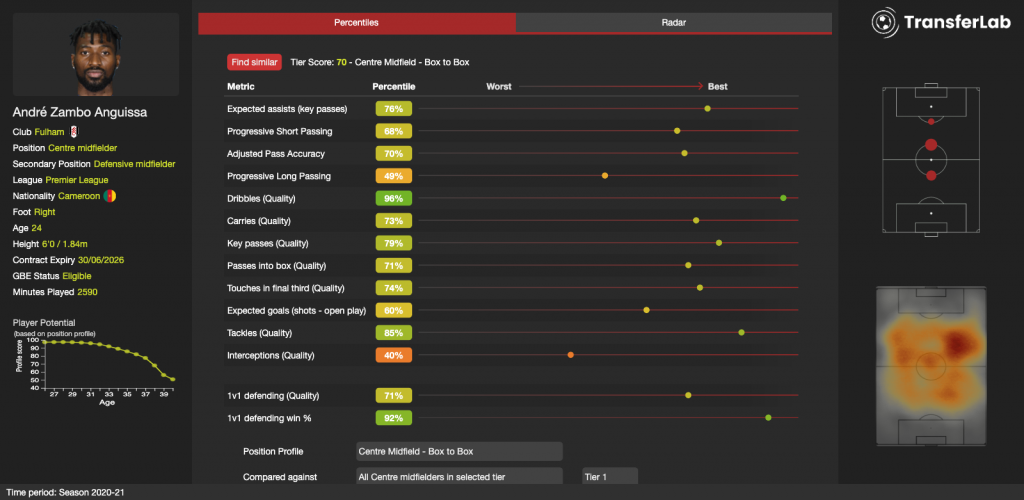
And so, when Fulham again went down, it was hardly a surprise that a club in one of the top leagues in Europe were waiting in the wings for the Cameroon midfielder.
Anguissa at Napoli
Luciano Spalletti’s Napoli came calling for Anguissa’s services on loan for the 2021/22 campaign, following Anguissa’s second Premier League relegation with Fulham. Spalletti had just arrived to replace the outgoing Gennaro Gattuso, and Napoli had lost Tiémoué Bakayoko following the end of the Frenchman’s loan the previous season. A strong, progressive central midfielder to complement Fabián Ruiz in an anchoring pair behind Piotr Zielinski appeared to be the desired criteria to replace Bakayoko.
A third-place Serie A finish for Napoli felt underwhelming, when they had contested the title with the Milanese clubs for so much of the season. This, coupled with three iconic players leaving Naples in Dries Mertens, Lorenzo Insigne and Kalidou Koulibaly, meant it was hard for anyone to be truly optimistic ahead of the 2022/23 season. That was until Napoli started playing, and at the time of writing Spalletti’s side sit top of the table, level with Atalanta, and lead their Champions League group.
A large part of their scintillating form is Anguissa, and his role within the midfield. Napoli line-up with a three-man midfield of Anguissa, Zielinski, and Stanislav Lobotka. On paper it reads as a two man pivot with Zielinski playing closer to the centre-forward in an attacking role, but in reality this trio move and shift to meet a range of in-game situations.

Napoli are a high possession side, holding over 61% of the ball this season (second only to Fiorentina) and last year led this metric across Serie A. This is not to say that they are a patient or ponderous side on the ball however, as they will look to progress the ball through the thirds as quickly and directly as possible. The first action is for Lobotka to drop deep between the wide splitting centre-backs whilst the goalkeeper has possession. This triangle offers a simple route of progression, and is complimented by the excellence of the Slovenian under these conditions. Small and strong, Lobotka will demand the ball even if he knows there is a heavy opposition presence close to him trying to win it. His slight size allows him to wriggle away from challenges taking players out of the game and putting Napoli onto the front foot. This is where Anguissa comes in.
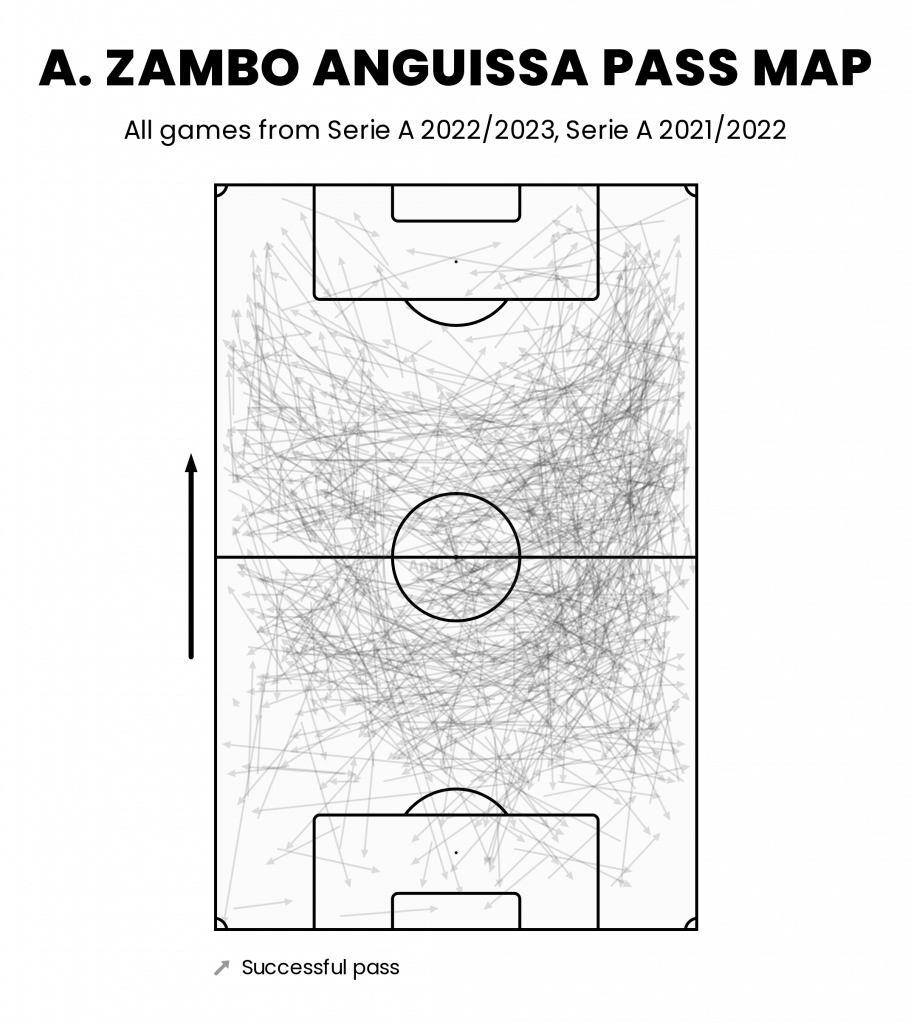
Many deeper midfield pairings will stay on the same plane as each other in possession, offering a stable and reliable triangle to rotate the ball with one of the centre-backs. This, however, can lead to slow periods of play without any thrust of progression up the pitch, for example Manchester United’s issues when Fred and Scott McTominay play together.
Spalletti and Napoli negate this by staggering their midfield in this phase of play. Lobotka will be the deepest, gathering possession and inviting pressure, before bursting clear and feeding Anguissa who is stationed more akin to an interior midfielder and in line with aggressive right-back Giovanni Di Lorenzo. The opposition have been thrown wide open, and Anguissa now has a plethora of options ahead and to each side. This is where the Cameroonian is at his very best, bodying opponents and powering through the midfield third to part the seas and open opportunities ahead of him.
This exceptional facet to Anguissa’s game is more than just a feast for the eyes. Among central midfielders across the traditional top five leagues (over the last 365 days), Anguissa’s 1.5 completed dribbles per 90 mins places him in the top 6%, and his 4.85 progressive carries places him in the 77th percentile. There are few central midfielders that carry and break forward into space like Anguissa does, although the loan arrival of Tanguy Ndombele does give Spalletti another player with this rare skillset (albeit an inconsistent one).
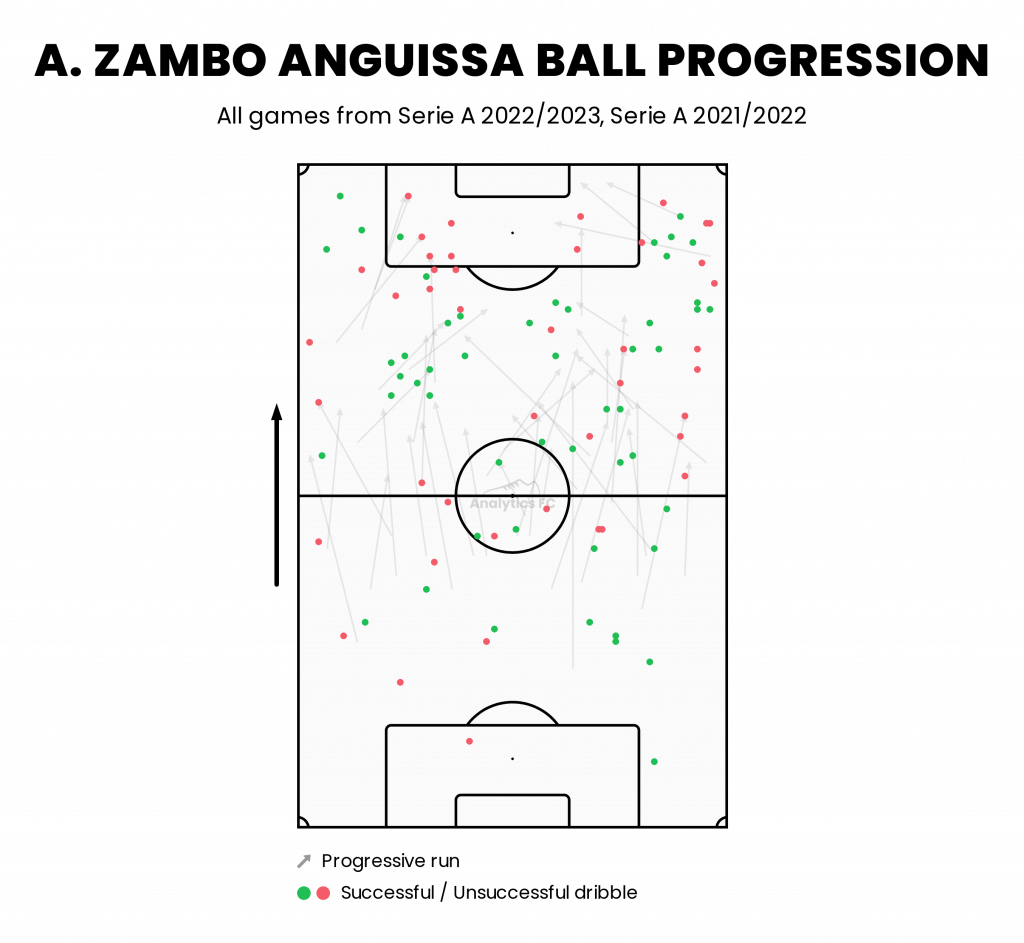
Anguissa’s feet are remarkably quick and give him the flurry of movement with which he can create separation from an opponent. His goal against Liverpool in the Champions League is a perfect example. Finding himself in the left half-space he fronts up two markers, both hesitant to close him down in fear of being beaten. Anguissa shimmies and cuts to his right, finding Zielinski for a neat one-two and simple finish. It is what makes Anguissa not only a brilliantly effective player, but also a joy to watch. A central midfielder who spins, pirouettes, and dances across the turf with the confidence of a joga bonito-like confidence.
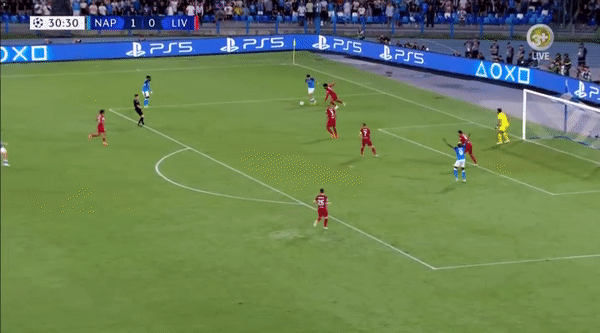
This approach is made possible by the coach’s philosophy and player’s capabilities aligning perfectly. Spalletti’s sides hold a lot of the ball, but do so at the very base of midfield to lure pressure and open space further forward. The speed with which they move into these spaces and propel forwards through players like Anguissa even gives the impression that they are a team that plays in transition, rather than being the ball hogging machine they actually are. The press resistance and carrying offered by Anguissa, in tandem with Lobotka, are two essential enabling factors in allowing Napoli to attack in this way and progress through the thirds so powerfully and directly.
Off the ball, the pair operate as a traditional two. When Napoli press high, Zielinski joins Victor Osimhen to press the centre-backs to create a 4-2-4 shape, leaving Anguissa and Lobotka to manage the space around the opposition central midfielders. Should this phase be bypassed, Napoli retreat into a compact mid-block 4-2-3-1 shape. Zielinski this time will marshal the holding opposition midfielder, and the deeper pair will look to cut out passing lanes. Anguissa’s 2.33 interceptions per 90 place him in the upper 12% for players in his position, reading space and reacting rather than seeking to engage too often.

This is why Anguissa has been such a success at Napoli: a defined role in a quality team with a manager who can get the best from him, playing with players who complement his role and function. And while his long passing and 1v1 defending has declined, Anguissa is now comfortably among the best box-to-box midfielders in Europe’s Top Five leagues, according to TransferLab. His improvement across the board is clear, with five metrics in the 80% percentile or above. Interestingly, while his all-round game is considerably better, the only season where he managed more than five metrics with 80% or over was…his first season at Fulham, where he got six, mostly defensive metrics. But as an all-rounder, he’s without question better now.

Doing a Fulham?
According to this piece in Forbes, splashing the cash as a newly-promoted Premier League side is called “doing a Fulham”. The piece calls that characterisation ‘lazy’, and goes on to make some very astute points about exactly why the window went bad, echoing what we have said above: injury, tactics, and having a weaker squad in the first place do not a bad window make. The problem with players coming in under such circumstances, injuries notwithstanding, is that it makes assessment of them, relative to outlay and, especially, given the Premier League’s hubristic approach to judging players – if they don’t make it here, they can’t really be that good – very hard.
But the case of André-Frank Zambo Anguissa shows that judging players against the backdrop of a relegation battle is hard, very hard. This is especially so when the player is injured for much of the season, the club has three different managers, and the player’s role isn’t exactly fixed or fitted. Anguissa struggled heroically and put up great defensive numbers in that relegation season. Moving to a club where he had a fixed role under a manager who nurtured him, he grew and returned to Fulham a better player where, again, he performed very well even as the club struggled as a whole. And now he is a midfield mainstay of a side challenging for Serie A again.
The upshot of this, then, is that we probably shouldn’t be so quick to judge. While headlines like “The worst £100million ever spent” attract attention and clicks, and £25 million ‘flops’ and ‘frauds’ make good copy, players need to be assessed far more thoughtfully. Anguissa shows that a nuanced assessment, over a number of seasons, and in conditions that allow a player to flourish, is far more useful and valid. And, in truth, Mitrovic’s signing shows the same. While Tony Khan’s overall strategy had flaws, at least 45% of Fulham’s investment has proven to have been wise, even if Fulham did not exactly reap the rewards with Anguissa. But he was right to sign the player; it’s just a shame for Fulham, and Khan, that the backdrop to his signing made it so hard to evaluate how good he would become at the time.
Header image: Shutterstock/MaciejGillert

